Living in Boquete, Panama, one is already immersed in a colorful landscape reminiscent of a painting, surrounded by nature where coffee trees cover the surrounding mountains and native citrus plants and flowers thrive in their respective micro-climates. One need not leave the “valley of flowers” or pastoral mountains surrounding the area to experience a wide range of scenic hikes and outdoor activities available in such a tranquil environment. And yet, everyone needs a road trip every now and then, if only to soothe the busy mind and leave the cares of daily life behind. A winding road trip through the mountains and over the scenic river crossings and waterfalls to Cerro Punta provides just such a therapeutic adventure.
On this particular Saturday morning in April, we began our adventure just as the rainy season was beginning to hint that it was rolling in. The overcast morning with mist gently falling provided the perfect mood for our day ahead. On any given day of the week but Saturday, Morton’s Bakery at San Francisco Plaza provides the ideal launching off spot to start your journey. Pack a couple of fresh bagels then take Ruta Sur Highway south away from the main highway that runs through town. As we set out on our way along the paved Ruta Sur road heading away from Boquete we began to leave all the casas behind and soon found ourselves curving along a winding road covered with trees of oak and ash that were hundreds of years old.
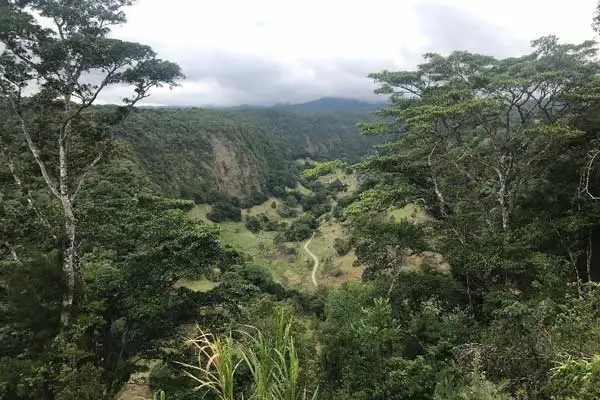
The Ruta Sur Highway stretches over canyons through the lush Highlands of Chiriqui connecting many of the small villages where much of the food and vegetables in the area are locally grown provided. The road itself is a cyclist's dream and yet should still be considered high risk for bikes.
We continued through spectacular canyon vistas as we wound our way through Cordillera and Potrerillos, stopping frequently for photos.
Our first stop along the way was a simple wooden-looking shack in Paraiso de Boquerón where pure cane sugar has been processed for decades. The town Paraiso means “paradise.” We were warmly welcomed in by the local owners along with their dogs who were hard at work early on a Saturday morning. Afterward, we were treated to watch and participate in the process of sugar being cooked down in a cauldron. We were then offered the fresh pure cane juice by the glass. The owners kindly served us cheese and bienmesabe, a rich dessert handmade on site. We each took turns running the sugar cane through the mill for processing. More than a hundred years ago, the railroad originally came from David to Potrerillos to Boquete to transport the sugar and brought more expats and development to the area.
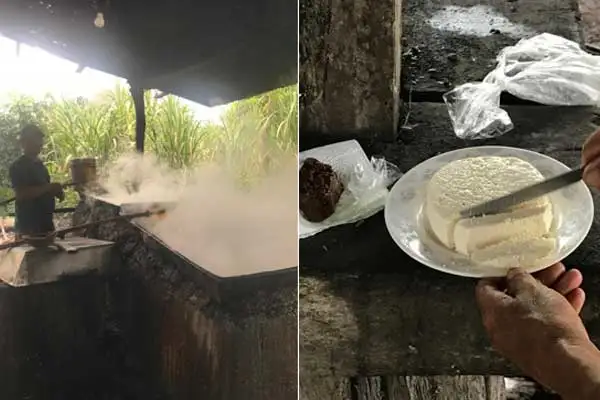
Our next stop was to take a short stretch and hike across the Rio Piedra Bridge. The walking suspension bridge overlooks the Canyon del Macho de Mante with rushing water cascading over the enormous rocks and boulders from the already early rains. As we continued our drive toward Cerro Punta, we happened upon a small casa with a nursery filled with dahlias of all colors and sizes. This is not to be missed for a photo op or a chance to bring some dahlias home for your garden.
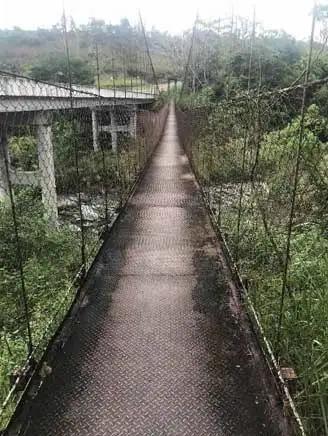
By the time we made our way into the town of Volcan, the rain was coming down and it was time for lunch. There is a little-known secret that the best enchiladas in all of Chiriqui can be found at the tiny family-run restaurant Burricos Mexican Grill. The owner is from Mexico and his lovely wife is from Panama, thus the authentic enchiladas can be found nowhere else in the area.
Get Your Free Panama Report Today!
Get Your Free Panama Report Today!
Learn more about a healthier outdoor life in Panama in our daily postcard e-letter.
Simply enter your email address below and we'll send you a FREE REPORT -- Panama: Easy, First-World Living and the World’s Best Retiree Program.

By submitting your email address, you will receive a free subscription to IL Postcards, Overseas Dream Home, The Untourist Daily and special offers from International Living and our affiliates. You can unsubscribe at any time, and we encourage you to read more about our Privacy Policy.
As one makes their way into the town of Cerro Punta it is like stepping back into another time and another place. The road and scenery begin to take on the texture and color and richness of the Swiss Alps. Triangular houses and hotels of Swiss design begin to line the road along the way. The mountains grow steeper and become completely covered with tiers of coffee and plots of vegetables of all kinds running up the entire slope of the mountains. The mountainscapes takes on the appearance of an old quilt with many patterns sewn together.
Cerro Punta is made up of four villages, Las Miranda, Guadalupe, Las Nubes, and Bajo Grande. It is said that Cerro Punta provides Panama with roughly 80% of its vegetables. It is eye-catching as one notices that not a single square foot of land has gone unused to grow cabbage, potatoes, onions, carrots, strawberries, and all other varieties of produce. Strawberries are the specialty of the area and can grow year-round in such a rich climate. It is no surprise, as Cerro Punta is the hub for much of the produce and food to other surrounding communities in Chiriqui.
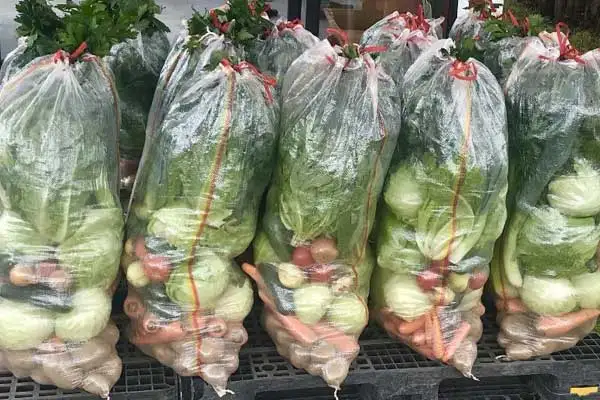
Driving through the heart of Cerro Punta, all the colors become much richer and more vivid. Bougainvillea of purples, pinks, and red line the streets. Entrances to simple homes are covered in greenery except for the entrances to the doorway. Plants and vegetables for sale from individual stands fill the streets. Our trip would not be complete without stopping beside the road for a 50-pound bag of fresh vegetables for $10. We were able to share this among three people. This will make enough soups for a month. When one considers the time, the cultivation, and the work that went into one bag for only $10 it puts things into humbling perspective. In the center of town, streets are lined with a variety of small shops and stands with such offerings as chorizos on sticks, or cups of strawberries and cream.
We could not end our trip to Cerro Punta without making our way up the slope of one of the mountains overlooking the villa. In this particular area, hydrangeas of blue, pink, and white began to line the streets and fronts of simple houses. On this particular slope, we watched in awe as workers with hundred-pound bags of coffee beans worked their way up tiers along the entire side of the mountain.
Perhaps the highlight of our day trip was on our way home where we made a stop at a little-known and rarely visited site called Sitio Barriles. Sitio Barriles is considered one of the most important archaeological sites in Panama. We were greeted by the lovely hostess, Edna, and her husband. Edna’s family have been the caretakers of the site for generations. The site was named for several stone barrels which were discovered on the site, carved by hand out of volcanic rock. The significance of the site is that it was believed to be populated by groups of people of Chinese and African origin dating as far back as 1,000 years B.C. Statues were discovered in the 1940s depicting a society that lived on the land as well as many unique artifacts, tools, and pottery. We were able to tour the site, making our way down a winding stairwell that showed layers of pottery and statues uncovered in the ground a dozen meters below. We were able to view sophisticated carvings and pottery done by hand into stone with amazing detail. It is believed that a volcanic eruption of nearby Volcán Baru in 600 A.D. was thought to have devastated much of the area and disbursed the people that were there at this time.
Edna’s tour would not be the same without her five Dalmatians joining us on our rounds. It was our good fortune to have arrived on this particular day as Edna and her husband were in the process of their monthly coffee roasting in the old traditional Panamanian style. We watched over the fire as the coffee beans were stirred in a steel pot until the precise moment of readiness. Edna then did the cooling by sifting the roasted beans with another pot by hand.
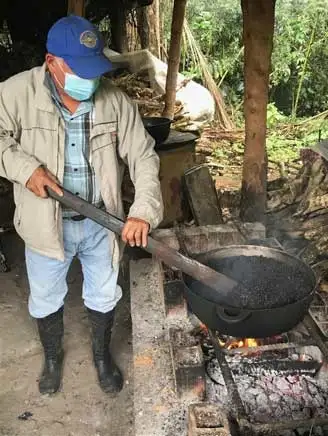
Following our tour, Edna served us a generously prepared spread of her homemade jams, Naranjillo and Blackberry, with crackers. We were able to purchase generous servings of each for just $2. As the scent of dark, almost burnt, roasted coffee filled the rainy air I was able to sweet-talk Edna into selling me a fresh roasted bag. It kept my hands warm for the rest of the day and we each took turns smelling it on the ride home.
As we made the lazy drive back to Boquete, the rain began to come down heavier, perhaps the first rain of the rainy season. We would likely have fallen asleep for an afternoon siesta had it not been for the pure cane sugar and Naranjillo jam still coursing through our veins. We arrived home just before dinner, each of us conversing on the beauty of the day and the richness of scenery and kindness of people to be found around Boquete and the Chiriqui Valley.
If you have not yet made a day trip to Cerro Punta, you must put it on your list. It offers a short adventure from Boquete and a glimpse into a much simpler and more agrarian way of life. Be sure to tell Edna we said “Hola.”
Get Your Free Panama Report Today!
Get Your Free Panama Report Today!
Learn more about a healthier outdoor life in Panama in our daily postcard e-letter.
Simply enter your email address below and we'll send you a FREE REPORT -- Panama: Easy, First-World Living and the World’s Best Retiree Program.

By submitting your email address, you will receive a free subscription to IL Postcards, Overseas Dream Home, The Untourist Daily and special offers from International Living and our affiliates. You can unsubscribe at any time, and we encourage you to read more about our Privacy Policy.
